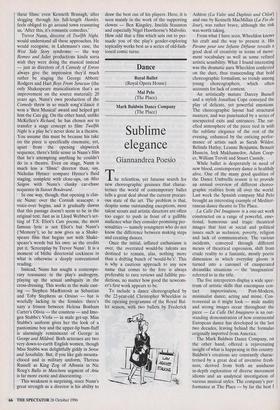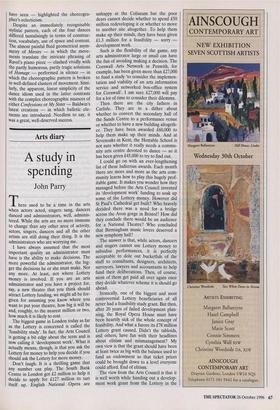Dance
Royal Ballet (Royal Opera House) Mal Pelo (The Place) Mark Baldwin Dance Company (The Place)
Sublime elegance
Giannandrea Poesio
The relentless, yet fatuous search for new choreographic geniuses that charac- terises the world of contemporary ballet tells a great deal about the current precari- ous state of the art. The problem is that, despite some outstanding exceptions, most talent scouts and artistic directors are often too eager to push in front of a gullible audience what they consider promising per- sonalities — 'namely youngsters who do not know the difference between making steps and creating dances.
Once the initial, inflated enthusiasm is over, the overrated would-be talents are destined to remain, alas, nothing more than a drifting bunch of 'would-be's'. This is why a cautious approach to any new name that comes to the fore is always preferable to rave reviews and fallible pre- dictions, no matter how good the newcom- er's first work appears to be.
To include a dance choreographed by the 22-year-old Christopher Wheeldon in the opening programme of the Royal Bal- let season, with two ballets by Frederick Ashton (La Valse and Daphnis and Chloe) and one by Kenneth MacMillan (La Fin du Jour), was rather brave, although the risk was worth taking.
From what I have seen, Wheeldon knows his craft and the way to present it. His Pavane pour une Infante Defunte reveals a good deal of creativity in terms of move- ment vocabulary as well as some refined artistic sensibility. What I found interesting was the dramatic aura Wheeldon conferred on the duet, thus transcending that bold choreographic formalism, so trendy among young choreographers, which often accounts for lack of content.
An artistically mature Darcey Bussell and a stylish Jonathan Cope conveyed the play of delicate, yet powerful emotions. The choreographic layout had structural nuances, and was punctuated by a series of unexpected exits and entrances. The rar- efied atmosphere of the piece tied in with the sublime elegance of the rest of the evening, enhanced by the enticing perfor- mance of artists such as Sarah Wildor, Belinda Hatley, Leanne Benjamin, Benazir Hussein, Irek Mukhamedov, Adam Coop- er, William Trevitt and Stuart Cassidy.
While ballet is desperately in need of new blood, contemporary dance is healthily alive. One of the many good qualities of the Dance Umbrella season is to provide an annual overview of different choreo- graphic realities from all over the world. Last week the Spanish company Mal Pelo brought an interesting example of Mediter- ranean dance theatre to The Place.
La Calle Del Imaginero is a one-act work constructed on a range of powerful, emo- tional, humorous and tragic theatrical images that hint at social and political issues such as seclusion, poverty, religion and lack of communication. The various incidents, conveyed through different means of theatrical expression, shift from crude reality to a fantastic, mostly poetic dimension in which everyday gloom is turned into a carousel of exasperated dreamlike situations — the 'imagination' referred to in the title.
The five interpreters display a wide spec- trum of artistic skills that encompass con- tact improvisation, Post-Modern, minimalist dance, acting and mime. Con- troversial as it might look — male nudity and strong images occur throughout the piece — La Calle Del Imaginero is an out- standing demonstration of how continental European dance has developed in the last two decades, leaving behind the formulas originally imported from America.
The Mark Baldwin Dance Company, on the other hand, offered a rejuvenating insight of what is happening in this country. Baldwin's creations are constantly charac- terised by a great deal of inventive fresh- ness, derived from both an assiduous in-depth exploration of diverse movement idioms and an analytical investigation of various musical styles. The company's per- formance at The Place — by far the best I have seen — highlighted the choreogra- pher's eclecticism.
Despite an immediately recognisable stylistic pattern, each of the four dances differed tantalisingly in terms of construc- tion, vocabulary, use of space and content. The almost painful fluid geometrical asym- metry of Miroirs — in which the move- ments translate the intricate phrasing of Ravel's piano piece — clashed vividly with the partly humorous, partly tragic solutions of Homage — performed in silence — in which the choreographic pattern is broken in well-defined clusters of movement. Simi- larly, the apparent, linear simplicity of the dance idiom used in the latter contrasts with the complex choreographic nuances of either Confessions or My Sister — Baldwin's latest creations — in which balletic ele- ments are introduced. Needless to say, it was a great, well-deserved success.



















































































 Previous page
Previous page